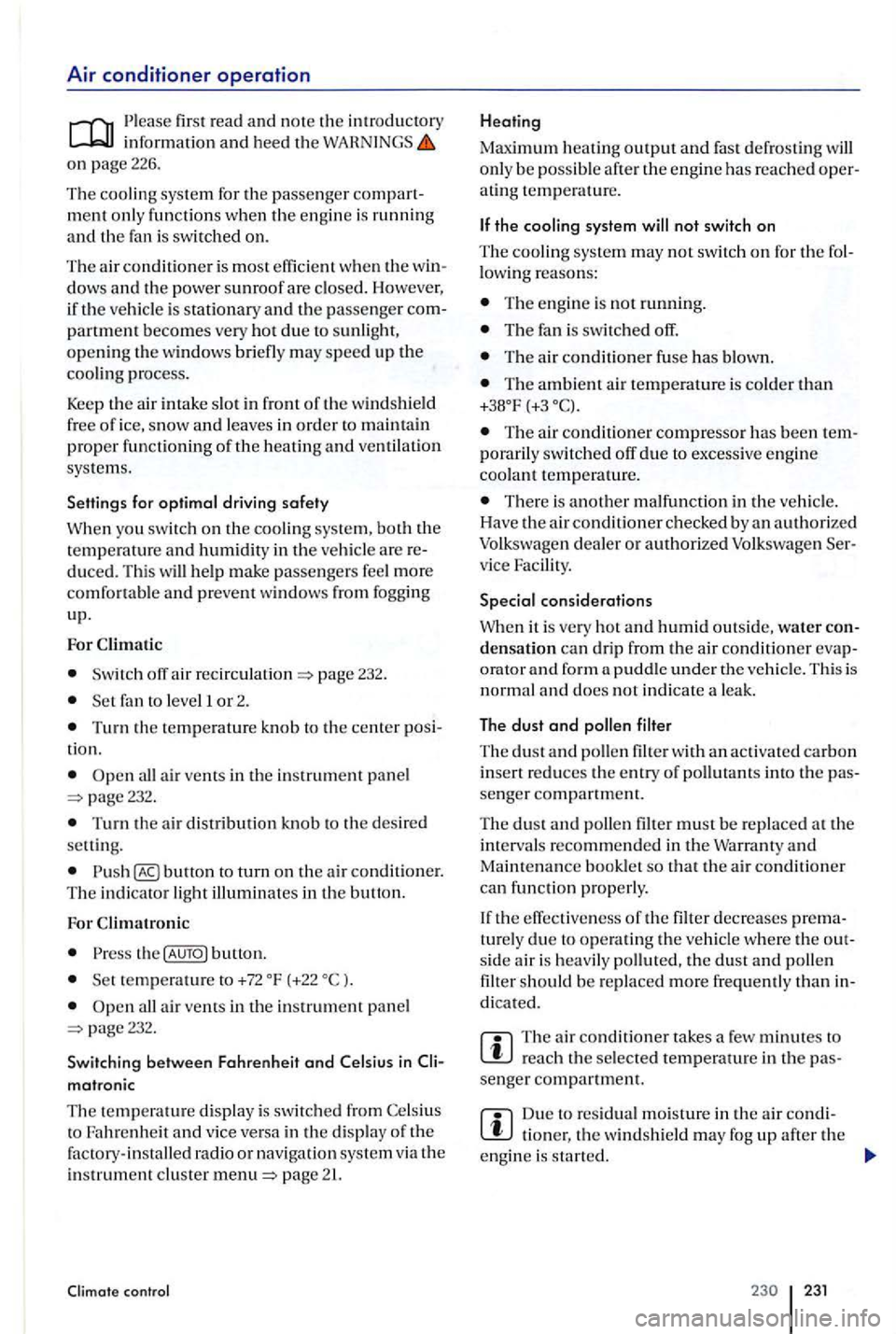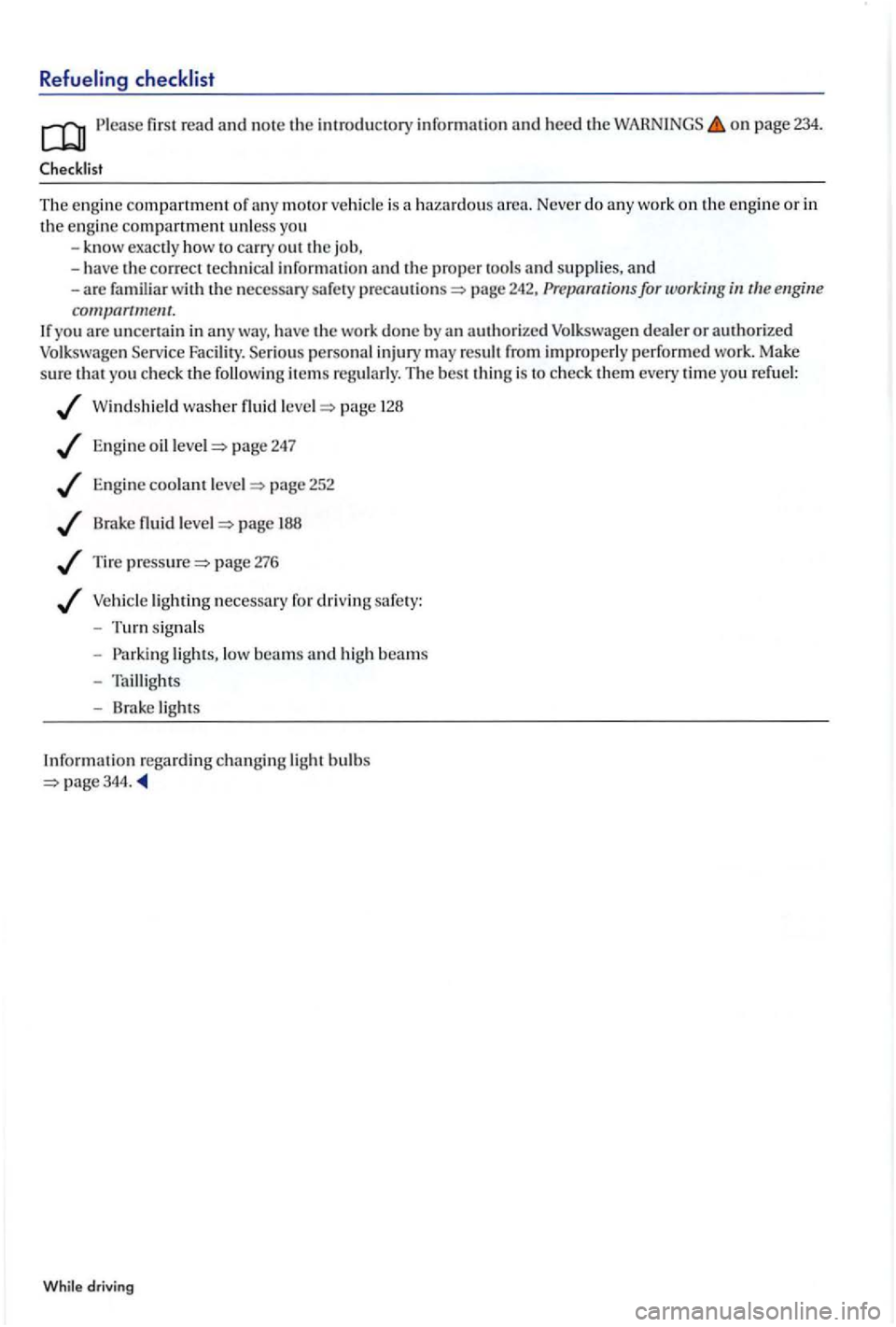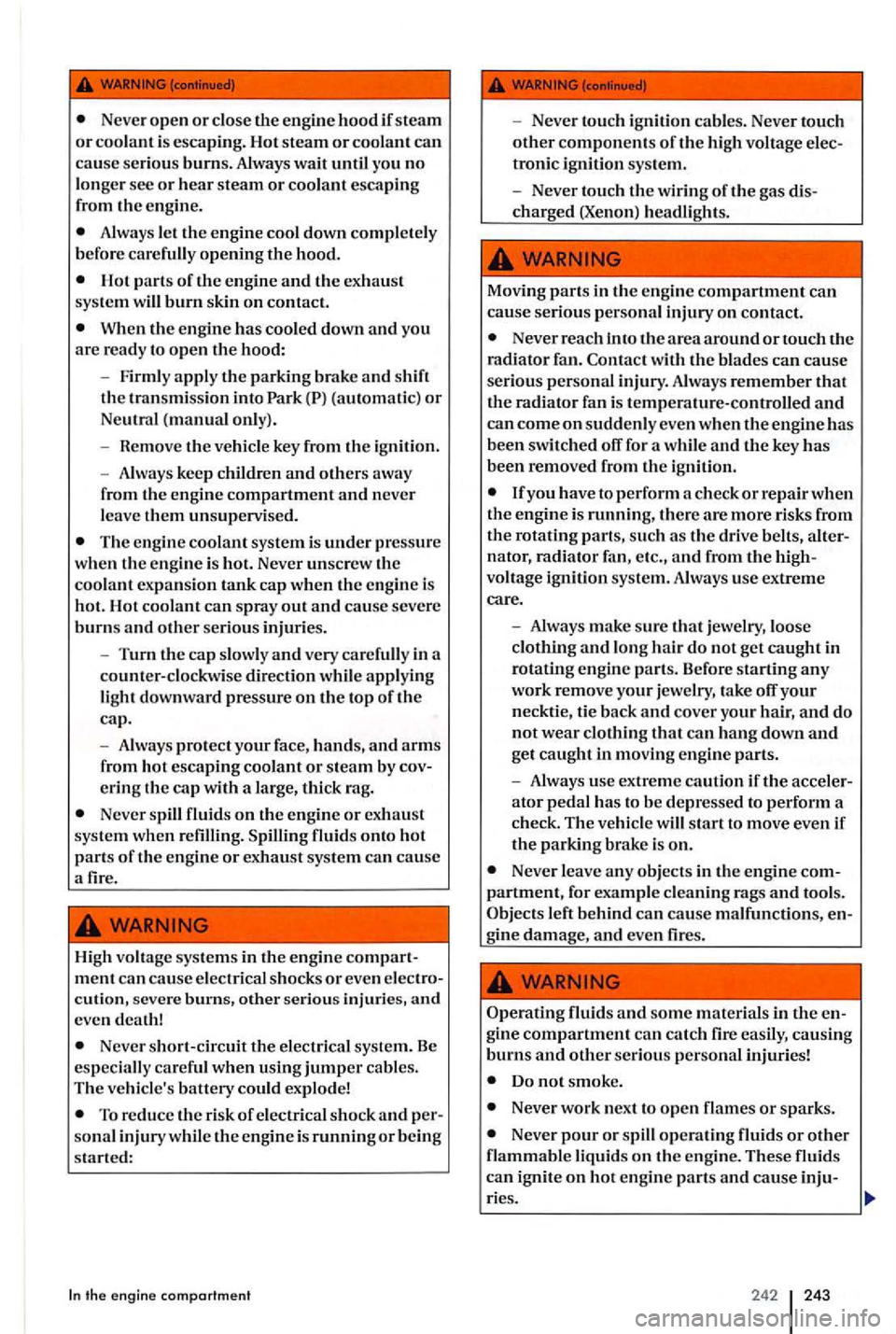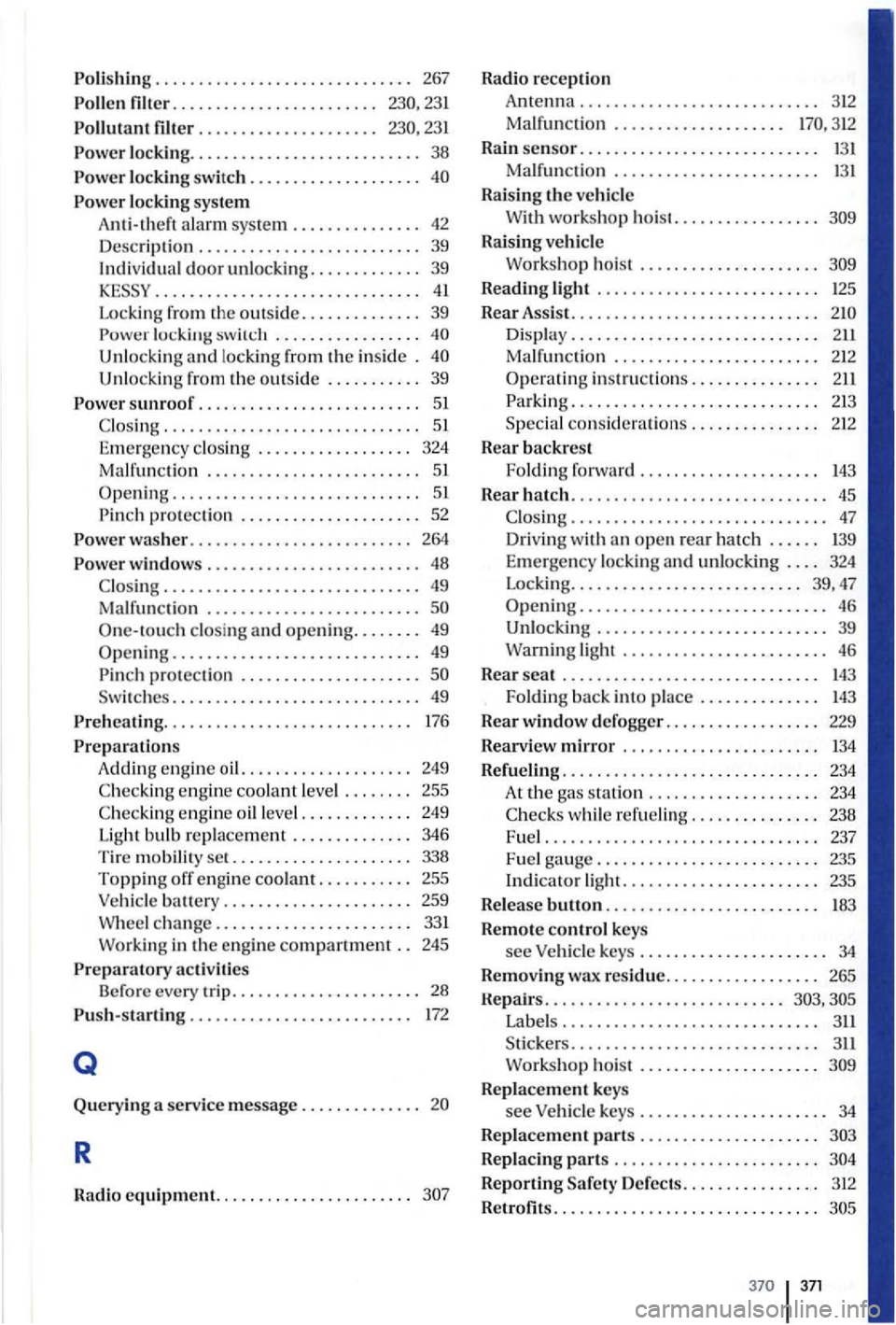2007 VOLKSWAGEN GOLF PLUS Check coolant
[x] Cancel search: Check coolantPage 228 of 541

Air conditioner operation
information and heed the WAHNINGS on page 226.
The cooling syste m for the passenger compart
ment o nl y functions when the engin e is running
and the fan is switched on.
The air conditioner is most efficient when the w indows an d the power sunroof are closed. However,
if th e vehicle is sta ti o nary and the passenger compartment becomes very hot due to sunlight, opening the w indows briefly may speed up the cooling proce ss.
Keep
the a ir intake slot in front of the windshield
free of i ce, snow and lea ves in order to maintain proper funct ioning of the heating and ventilation systems.
Settings for optimal driving safety
When yo u sw itch on the cooling system, both the temperature and humidity in the vehicle are reduced. Th is will help make passengers feel more comfo rtable and prevent windows from fogging
up.
For
Sw itch off a ir page 232.
fan to Ievell or 2.
T urn the temperature knob to t he center posi
tion.
all air vents in the in strument panel page232 .
Turn the air distribution knob to the des ired settin g.
butto n to turn on the air conditioner. The indicator light illumin ate s in the button.
For
th e button.
temperature to +72
pa ge232.
Sw itching between Fahrenheit and Celsius in Cli
matronic
The t empe ratu re disp lay is switched from to Fahrenheit and vice versa in the display of the factory- in stalled radio or naviga tion system via the in strument cluster page
control
H eating
Maximum heating output and fas t defrosting will
only be possib le a fte r the e ngin e has reached operating tempe rature.
T he e ng in e is not running.
T he fan is switc hed off.
The a ir conditi one r fuse has blown.
The ambien t a ir temperature is colder than (+3
T he air condition er compresso r has been tem
porarily switched off due to excess ive engin e coolant temperature.
The re is a nother malfunction in the ve hicle.
Ha ve the ai r conditioner checked by an authorize d
Volkswage n dealer or authorized Volkswage n Ser
v ice Facility.
Special considerations
Whe n it is very hot and humid outside, water con
d ensation can drip from the air condition er evaporator and form
The air condit ioner takes a few minutes to reach the selected temperature in the passenger compartment.
Due to residual m oisture in the air condi tione r, th e windshi eld may fog up after the
engi ne is s tarted.
23 1
Page 235 of 541

Refueling checklist
first rea d an d note the introductory information and heed the on page 234.
The engi ne compartment of moto r vehicle is a haza rdous engine or in the engin e compartment unless yo u -know exac tl y how to carry o ut the job,
-have the correct technical in formation and the proper too ls and supplies, and -ar e familiar with the necessary safety precautions page 242, Preparation s for working
have the work done by an authorized Volkswagen dealer or authorized Volkswag e n Serv ice Facility. Ser ious personal injury may result from improperly perform ed work. Make
s ure that y ou check the followin g item s re gu larly. The bes t thin g is to check them every time you refue l:
Wind sh ie ld was her fluid leve l page 128
E ng in e oil leve l page 247
Engin e coolant leve l page 252
Brake fluid level page 188
Tire pressure page 276
Vehicle lighting necessary for drivin g safe ty:
-Turn signal s
-
li ghts, low beams and high beams
- Taillights
- Brak e light s
Inf
ormat ion regard ing changing light bul bs page 344.
While dri ving
Page 240 of 541

Never open or close the engine hood if steam or coolant is escaping. Hot steam or coolant can cause serious burns. Always wait until you no longer sec or hear steam or coolant escaping
from the engine.
Hot parts of the engine and the exhaust
system will burn skin on contact.
When the engine has cooled down and you are ready to open the hood:
- Firmly
apply the parking brake and shift the transmission into Park
The engine coolant system is under pressure when the engine is hot. Never unscrew the coolant expansion tank cap when the engine is
hot. Hot coolant can spray out and cause severe burns and other serious injuries.
- Turn
the cap slow ly and very carefully in a
counter-clockwise direction while applying
light downward pressure on the top of the cap.
- A
lways protect your face, hands, and arms from hot escaping coolant or steam by
Never spill fluids on the engine or exhaust
system when Spilling fluids onto hot parts of the engine or exhaust system can cause a fire.
High voltage systems in the
engine com ment can cause electrical shocks or even
Never short-circuit the electrical system. Be especially careful when using jumper cables. The vehicle's battery could explode!
To reduce the risk of electrical shock and sonal injury while the engine is running or being started:
the engine compartment
- Never touch ignition cables. Never touch other components of the high voltage tronic ignition system.
- Never touch
the wiring of the gas
Never reach into t11e area around or touch the
radia tor fan. Contact with the blades can cause serious personal injury. Always remember that the radiator fan is temperature-controlled and can come on suddenly even when the engine has been switched for a while and the key has been removed from the ignition.
lfyou have to perform a check or repair when the engi ne is running, there are more risks from tl1e rotating parts, such as the drive belts, nator, radiator fan, etc ., and from voltage ignition system. Always use extreme care.
- Always make
sure that jewelry, loose clothing and long hair do not get caught in rotating engine parts. Before starting any work remove your je welry, take
parking brake is on.
Never leave any objects in the engine
left behind can cause malfunctions,
Do not smoke.
Never work next to open flames or sparks.
Never pour or spill operating fluids or other flammable liquids on the engine. These fluids can ignite on hot en g in e parts and cause ries .
242 243
Page 252 of 541

read and note the introductory
on page 252.
If th e coolant level drops too low, the engin e
coo lant level/ tempe ratur e warni ng ligh t lights up.
Park the ve hicl e on level ground.
Always let the engin e cool
th e engine hood
There is a fig.
When the eng in e is co ld, check the e ngine
coolant leve l relat ive to th e marking on th e sid e of th e expa nsio n tank fig. 154.
Always protec t face, hands and arms from h ot
escaping coo lant o r steam by cover ing the cap with a larg e, thi ck rag.
Carefully unsc rew the
Add new engine co olant ac co rding to Volkswagen specifications page 254)
Th e engi ne coo lant leve l must b e in sid e the mark s on the sid e of the 154. Do
not above top edge of the
the engine compartment
Fig. 155 Coolan t e xpans ion tank cap in the eng in e
compartment.
Screw the lid tightly.
Even in a n em erge ncy, do not use any other kind of coolant addi tive if eng ine coolant meeting
Volkswagen pa ge 254) is una v ail
able! Instead, add distilled water
page 254.
H
ot steam and hot engin e coo lant can cause se
rio us burns.
Never open the hood if yo u sec steam o r coolant esca ping from the engine compartment. Always wait until you no longer see or hear steam or coolant escapin g from the engine.
Always let the e ngin e cool down compl etel y
before carefully opening th e hood.
When the engin e has coo le d down and you are ready to open hood:
- F
irmly apply the parking brake and shift (automatic) o r Neutral (manual only).
- Hemov e
the vehicl e key from the ignition.
- Always keep c
hildren and others away from the en gin e compartment and never
leave them unsupervise d.
The engine coolant system is under pressure
w hen the engine is hot. Neve r unscrew the coolant expansion tank cap whe n the engine is hot. Hot coolant can spray out and ca use severe burns and other serious injuri es.
254 255
Page 368 of 541

. . . . . . . . . . . . . . . . . . . . . . .
locking . . . . . . . . . . . . . . . . . . . . . . . . . . . 38
locking switc h ....................
switch .................
sunroof . . . . . . . . . . . . . . . . . . . . . . . . . . 5 1
C losing ................ 51
Eme rgen cy clos ing . . . . . . . . . . . . . . . . . . 324
Malfun ction ............ 0............ 51
Opening ............... pro tec tion .......... 52
was her .. o o o
windows .
One-to uch closing an d openin g ........ 49
Opening ...... 49
pro tec tion ...
Switch es ................
.......... o 176
Adding e ng in e oi l. ............ ....... 249 C heckin g engin e coolant leve l . . . . . . . . 255
Checking engin e oil leve l. 249 Light bulb re p lace ment .. 346
T ire m obilit y set ..................... 338
Topping off en gin e c ool ant. . . . . . . . . . . 255 Vehicl e battery ............
331
Workin g in the engine compartment .. 245
activities Befo re every trip .........
.... 172
Q
Que ry ing a service message ..... o
R
Rain sensor ..... ........ .... 13 1
Malfun ctio n .............. .. 13 1
Raising the vehicle
Witl1wor ksho p hoi
st. ......
Raising vehicle
Workshop hois t
.................
Reading light ............... 125
Rear Assist. . . . . . . . . . . . . . . . . . . . . . . . . . . . .
212
Operating in structi ons ..... ...... 211
. ..... .......
consid era ti o ns ........... 2 12
Rear backrest
F olding forward .. 143
Rear hatch ........... 45
C losing .............. ................ 47 Driving with an open rear hatch . 139
Eme rgency lockin g and unlocking . . . . 324 Locking ................... 39, 47
Opening ......... 46
U nl ocking .. o o o 39
Warn ing light . . . . . . . . . . . . . . . . . . . . . . . . 46
Rear seat ...... 143
Folding back into place . . . . . . . . . . . . . . 143
Rear window d efogger ..
234
A t th e gas statio n .................... 234 C hecks w hil e ref uelin g .........
237 Fue l gauge. . . . . . . . . . . . . . . . . . . . . . . . . . 235
Indicator light ............ o 235
R elease butto n . o 183
Remote control k eys
see Vehi cle keys ..
............. o
Labe ls. 311 Workshop ho is t ...... .. ..
Replac em ent ke ys
see Vehicle keys .................
Replacing parts ........
Reporting